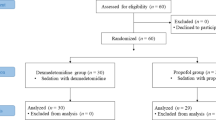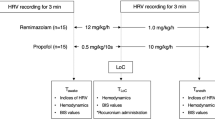Abstract
Purpose. Propofol augments the reduction of heart rate (HR) in combination with cholinergic agents and attenuates the HR response to atropine. We examined whether propofol anesthesia was associated with an increased incidence and extent of bradycardia after neostigmine-atropine administration compared with the effects of isoflurane anesthesia.
Methods. Thirty-six adult patients were randomly assigned to two groups (n = 18 each): the propofol group patients were anesthetized with propofol (5–10 mg·kg−1·h−1)-2O-fentanyl, and the isoflurane group patients were anesthetized with isoflurane (0.5%–1.0%)-2O-fentanyl. When surgery was completed, anesthetics were discontinued, and then a mixture of neostigmine 0.05 mg·kg−1 and atropine 0.02 mg·kg−1 was injected intravenously over 20 s. Blood pressure (BP) and HR were measured noninvasively at 1-min intervals for 10 min.
Results. At the completion of the surgery, the average infusion rate of propofol was 6.2 ± 1.7 mg·kg−1·h−1, and the average inspired concentration of isoflurane was 0.73 ± 0.15%. Immediately before the neostigmine-atropine injections, HR and mean BP were similar in the two groups. The maximum increase in HR after the neostigmine-atropine injections was significantly less in the propofol group than in the isoflurane group (16 ± 9 and 34 ± 6 beats·min−1, respectively, P < 0.01). The subsequent maximum decrease in HR was greater in the propofol group than in the isoflurane group (−9 ± 4 and −5 ± 4 beats·min−1, respectively; P < 0.01). The incidence of bradycardia (HR < 50 beats·min−1) after neostigmine-atropine injection was greater in the propofol group than in the isoflurane group (61% and 28%, respectively; P < 0.01).
Conclusion. We conclude that propofol anesthesia attenuates the initial increases in HR, enhances the subsequent decreases in HR, and increases the incidence of bradycardia after neostigmine-atropine injections compared with the effects of isoflurane anesthesia.
Similar content being viewed by others
Author information
Authors and Affiliations
Additional information
Received: May 21, 2001 / Accepted: August 29, 2001
About this article
Cite this article
Kimura, T., Tanaka, M. & Nishikawa, T. Comparison of heart rate changes after neostigmine-atropine administration during recovery from propofol-N2O and isoflurane-2O anesthesia. J Anesth 16, 23–27 (2002). https://doi.org/10.1007/s540-002-8090-6
Issue Date:
DOI: https://doi.org/10.1007/s540-002-8090-6




